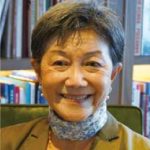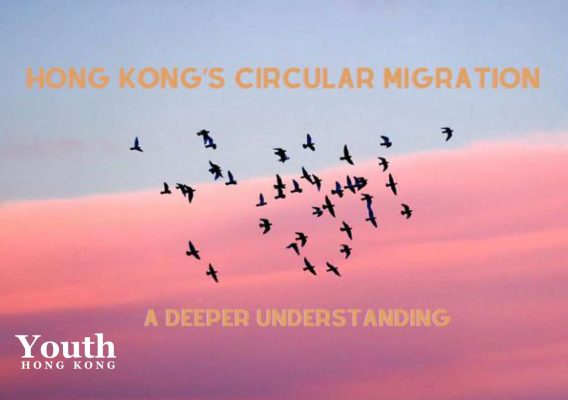//vol.14-3 Talking point
The Hong Kong Census and Statistics Department recently reported a 1.6% decline in the city’s total population from 7.41 million people to 7.29 million in August 2022. YHK talks to historian, Professor Elizabeth Sinn, about the ongoing migration wave and its parallels in history.
- Migration through and from Hong Kong is often circular, involving multiple trips through, out and back that characterize Hong Kong as an “in-between place.”
- A sense of deep familiarity and both emotional and cognitive attachment hold Hongkongers close to their home city, beside job security and career progression.
- While sense of belonging and identity remain fundamentally constant despite mobility, they are flexible and can be affected by “high temperature” or “low temperature” situations.
- 回望歷史,香港人口一直移動,可能因為工作、學習或其他原因,但冼教授相信有人離開,就必然會有人回來。
- 她亦觀察到,一種根深蒂固的熟悉感和情感上的依戀,令讓香港人更靠近家鄉。
- 儘管移民具流動性,但個人的歸屬感和認同感基本上會保持不變,不過它們亦仍然會受到某些因素形響,而這些因素或影響作為中國人和香港人的身分認同。
Hong Kong’s mid-year population in 2022 was 7,291,600, down 1.6% from mid-2021, according to the Census & Statistics Department (CSD). Declining birth rates have contributed to the fall, while the mortality rate has edged up, partly because of the ageing population. Nevertheless, the significant net outflow of 113,200 Hong Kong residents in the past year is already higher than in 2021.
Hong Kong’s population has always been mobile, for work, study and other reasons, both across its borders and to and from its port. The history of the phenomenon is recorded by Prof Sinn in her book, *Pacific Crossing: California Gold, Chinese Migration, and the Making of Hong Kong. She argues that migration through and from the city is often circular, involving multiple trips through, out and back that characterize Hong Kong as an “in-between place.”
…an in-between place …transformed …from a small-scale entrepôt of goods into a large-scale entrepôt of people
Defining Circular Migration
Another outstanding feature of Hong Kong migration and its transoceanic character is the way in which east-west trade with California invigorated the old Nam Pak trade that linked north and south China with routes to South and Southeast Asia. These routes intersected in Hong Kong, moulding it as a leading port of the 19th century. People as well as goods left from it, not just for California but for other parts of the world including Australia, Canada and New Zealand, transforming it into “the nerve centre for numerous business networks and empires.”
20th Century and Beyond
Although Hong Kong had a thriving local population by the 20th century, it remained an important in-between place. As Professor Sinn notes, it was a popular destination and transit point for mainland Chinese refugees escaping the Cultural Revolution in the late 1960s and 1970s, and also right after the Liberation of 1949. During the Vietnam War, refugee boat people used Hong Kong as a departure point for the US and other destinations, making up another round of migration.
The famine in the early 1960s was another form of migration that took place when families escaped from mainland China with their children. As Prof Sinn recalls, “When I was growing up in Hong Kong in the 50s, there were a lot of people leaving through Hong Kong. Some of them went to Taiwan, but Hong Kong was very often the first stop. It was very important at that time as a transit point for people from China going either to Canada or to America.”
In 1967, there was another rise in emigration because of the pro leftist, anti-colonial riots in Hong Kong. “Many people now forget that at that time, suddenly, almost overnight, some rich people who were really afraid that the communists would come, upped and left with their children although the numbers were very small.”
The next wave came in the late 1980s and 1990s when it was clear that Hong Kong would be returned to China. Hongkongers started applying to emigrate to western countries. “The government became very concerned because of the brain drain and lot of policy research was done on the impact. But some of these people started to come back a few years later if they couldn’t find good jobs in the States or Canada.”
This was the period of the “astronaut families” when fathers stayed in Hong Kong to make money while wives and children resided overseas. However, by the end of the 1990s, there were a lot of returnees.
By the end of the 1990s, there were a lot of returnees. That was an amazing wave. We talk about waves of immigrants, but we don’t talk about waves of returnees. If you talk to people who are in their 40s and 50s now, there are a lot of these returnees still here.
Full Circle Home
It would be really interesting to study future migration waves, says Prof Sinn and look for parallels. On a personal note, she wonders about her son and grandson. “Jack, my grandson is in England now. He’s 12 now and I can see him coming back after he graduates. Why not?”
Afterall, there are many reasons for the circular flow of people to and from Hong Kong, she points out. “I’m sure there will be people going and people coming back.” This matches in some ways the historical phenomenon which she described in “Pacific Crossing” and she thinks that today’s flow of people leaving from and returning to Hong Kong is part of an ongoing pattern.
Professor Sinn observes that a sense of deep familiarity and both emotional and cognitive attachment hold Hongkongers close to their home city. Speaking about her own peers as well as the younger generation, she notes that job security and career progression matter a lot. She emphasizes that the focus should be on the constant mobility and fluidity of movement. “As a Hong Konger, you get used to seeing people come and go.”
She says that Hong Kong’s role as an in-between place might eventually shift to destinations including other cities in the Greater Bay Area. “People will be moving around, like water finding its own level. Wherever there is an opportunity, people will go there.” Mobility will become more fluid, in effect. So-called “global citizens” might, for example, have ten homes all over the world and so do not fall into the traditional category of immigrants.
In a final remark, Prof Sinn says that while sense of belonging and identity remain fundamentally constant despite mobility, they are flexible and can be affected by situations. She calls these situations “high temperature” or “low temperature” moments and that some of these can affect the sense of being Chinese or of being a Hongkonger. When one is driven by “high temperature” moments such as loneliness, homesickness or even a particular craving for comfort foods like wonton noodles, a battle of strong emotions emerges that connect one firmly to one’s native place.
Any debate on identity entails not only individual feelings but also how we as individuals are perceived by others, Prof Sinn reminds us. Danger may lie in holding fast to personal beliefs and a self-absorbed bias that is too limited and blinkered. It can overlook the need for ongoing dialogue with members of other communities and fellow global citizens as well as those whose beliefs do not match one’s own. ![]()
 Born and educated in Hong Kong, Elizabeth Sinn is a historian with a general research interest in Modern China and Hong Kong and special interest in the history of charity, business, culture, the press and migration. Before retiring in 2004, she was the Deputy Director of the Centre of Asian Studies (University of Hong Kong) and a member of the University’s University Research Committee. Outside the University, she was a member of the Humanities Panel of the Hong Kong Research Grants Council. She has served on the Antiquities Advisory Board; Royal Asiatic Society (Hong Kong Branch) and also the Hong Kong Museum of History.
Born and educated in Hong Kong, Elizabeth Sinn is a historian with a general research interest in Modern China and Hong Kong and special interest in the history of charity, business, culture, the press and migration. Before retiring in 2004, she was the Deputy Director of the Centre of Asian Studies (University of Hong Kong) and a member of the University’s University Research Committee. Outside the University, she was a member of the Humanities Panel of the Hong Kong Research Grants Council. She has served on the Antiquities Advisory Board; Royal Asiatic Society (Hong Kong Branch) and also the Hong Kong Museum of History.


